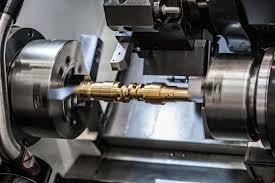In the world of precision manufacturing, small differences can have major consequences. One of the most critical—but often misunderstood—factors in CNC machining is tolerance. While it might sound like a simple concept, tolerance plays a pivotal role in ensuring your parts perform as expected, fit together correctly, and maintain long-term durability.
This article explores what machining tolerances are, why they matter, how they affect part performance and cost, and how advanced CNC turning services help achieve the precise tolerances needed in high-demand industries.
What Are CNC Machining Tolerances?
Tolerances in CNC machining refer to the permissible limit of variation in a physical dimension. Since no manufacturing process is perfect, tolerances define how much deviation is acceptable between a part’s actual measurement and its intended specification.
For example, a shaft might be specified as 10.00 mm ± 0.01 mm, meaning the actual size can range from 9.99 mm to 10.01 mm and still be considered acceptable.
Common Units for Tolerance:
-
Millimeters (mm)
-
Micrometers (µm)
-
Inches (in)
Tighter tolerances mean less variation, requiring more precise tooling, advanced machinery, and sometimes multiple quality checks.
Types of Tolerances in CNC Machining
-
Unilateral Tolerance: Variation allowed in only one direction from the nominal dimension.
-
Example: 50 mm +0.05/-0.00
-
-
Bilateral Tolerance: Variation allowed in both directions.
-
Example: 50 mm ± 0.02 mm
-
-
Limit Tolerance: Specifies a range using maximum and minimum limits.
-
Example: 49.98 mm – 50.02 mm
-
Tolerances are often based on international standards like ISO 2768, ASME Y14.5, or DIN norms, depending on the industry.
Why Tolerances Matter in CNC Machining
✅ 1. Functional Fit and Assembly
Precision parts often need to work in tandem with other components. Poorly controlled tolerances can cause issues such as:
-
Parts not fitting together properly
-
Excessive friction or wear
-
Mechanical failure in high-speed applications
A perfect example is seen in CNC turning services, where cylindrical parts like shafts and bushings must meet strict roundness and diameter tolerances to ensure proper function in assemblies.
✅ 2. Performance and Reliability
Tolerances directly impact how a product performs under stress, heat, and motion. Loose tolerances can result in vibration, noise, and part failure over time, especially in automotive or aerospace settings.
✅ 3. Interchangeability
In mass production, parts must be interchangeable. Tolerances ensure every part meets a standard size so replacements or upgrades can be made without requiring additional custom work.
Tolerances vs. Cost: Finding the Balance
Tighter tolerances almost always lead to higher production costs due to:
-
Slower machining speeds
-
More expensive tools
-
Increased inspection and quality control time
-
Higher scrap rates
That’s why it’s critical to only specify tight tolerances where absolutely necessary. Over-engineering tolerances for non-critical dimensions wastes time and budget.
Design Tip: Apply tight tolerances only to functional, interfacing, or wear-critical features.
How Tolerance Affects Different CNC Machining Processes
🔩 CNC Milling
-
Great for flat surfaces, slots, and intricate patterns
-
Standard tolerance: ±0.125 mm (can be tighter with advanced setups)
🔧 CNC Turning
-
Ideal for producing round, concentric parts
-
Standard tolerance: ±0.05 mm (can go down to ±0.01 mm or tighter)
With CNC turning services, tight tolerances are achievable on diameters, threads, tapers, and grooves—making it ideal for shafts, pins, bushings, and precision cylindrical components.
Industries Where Tight Tolerances Are Critical
-
Aerospace: Even the smallest deviation can compromise structural integrity or aerodynamic performance.
-
Medical Devices: Implants and surgical tools require ultra-precise machining for patient safety.
-
Automotive: High-speed rotating parts (e.g., crankshafts) must meet strict tolerance standards.
-
Defense & Firearms: Firearm components, such as barrels and slides, need tight fits for safety and accuracy.
How to Specify Tolerances in Your Design
When preparing a design for CNC machining:
-
Use standard tolerance tables unless a tighter fit is needed.
-
Add GD&T (Geometric Dimensioning and Tolerancing) if using complex shapes or interacting parts.
-
Clearly label critical features and avoid over-specifying non-essential ones.
-
Collaborate with your machining partner to find the most cost-effective and practical tolerances.
The Role of CNC Turning in Achieving Tight Tolerances
CNC turning is especially suited for parts with symmetrical round features. The rotational nature of the process allows for precise control over:
-
Outer diameters
-
Inner bores
-
Thread profiles
-
Surface finishes
Advanced CNC turning services utilize multi-axis lathes, automated tooling, and in-process metrology to hold tolerances as tight as ±0.005 mm, depending on the material and part geometry.
Surface Finish and Tolerance: Are They Related?
Yes. As tolerances get tighter, surface finish quality often becomes more critical. For example:
-
A sliding shaft may need both tight tolerances and a mirror finish to reduce friction.
-
Threaded parts require precise pitch and smooth surfaces to avoid galling.
Post-machining processes like grinding, lapping, or polishing are often used to enhance surface quality on tight-tolerance components.
Get It Right with the Right CNC Partner
Achieving consistent and precise tolerances requires:
-
Skilled machinists
-
Advanced machinery
-
Robust quality control processes
That’s why businesses across industries trust experienced providers of CNC turning services to deliver parts that meet stringent engineering requirements, on time and on budget.
Conclusion
Tolerances may seem like a technical detail, but they are the foundation of functionality in any machined component. Whether it's a critical aerospace bracket or a rotating automotive shaft, precise tolerances ensure parts work as intended—every time.
If you're unsure about how tight your tolerances need to be, or if you're looking for expert-level support in producing complex precision parts, consider reaching out to specialists in high-accuracy machining.
Explore expert CNC turning services today:
🔗 https://cnc-machiningservices.com/service/cnc-turning-services/
